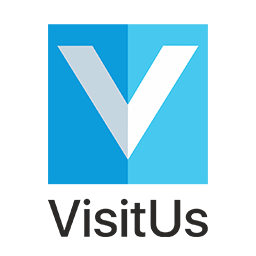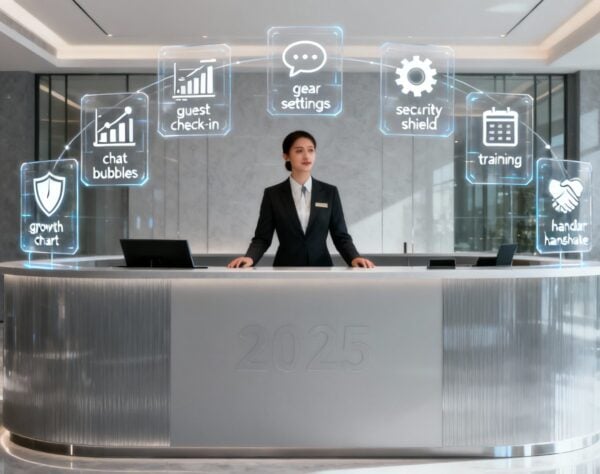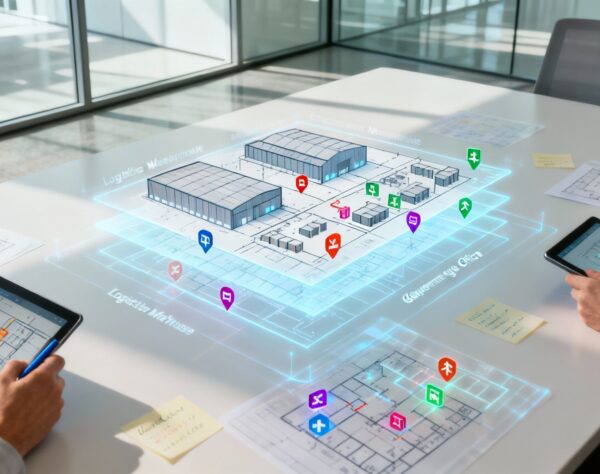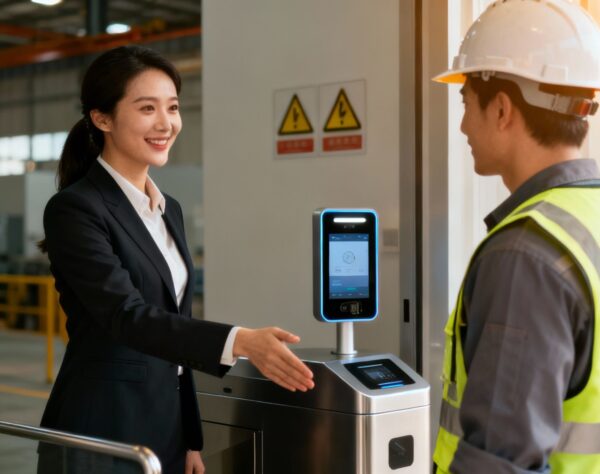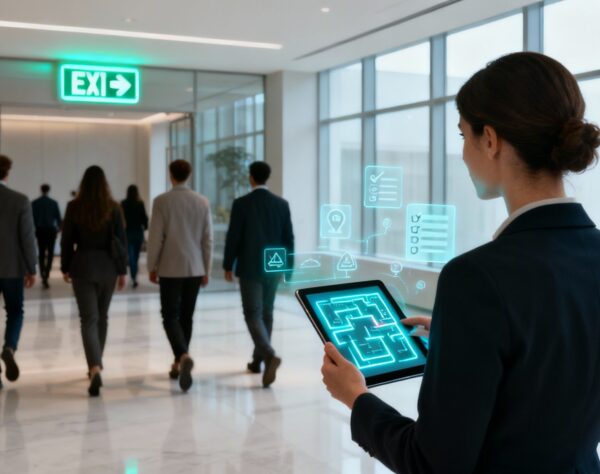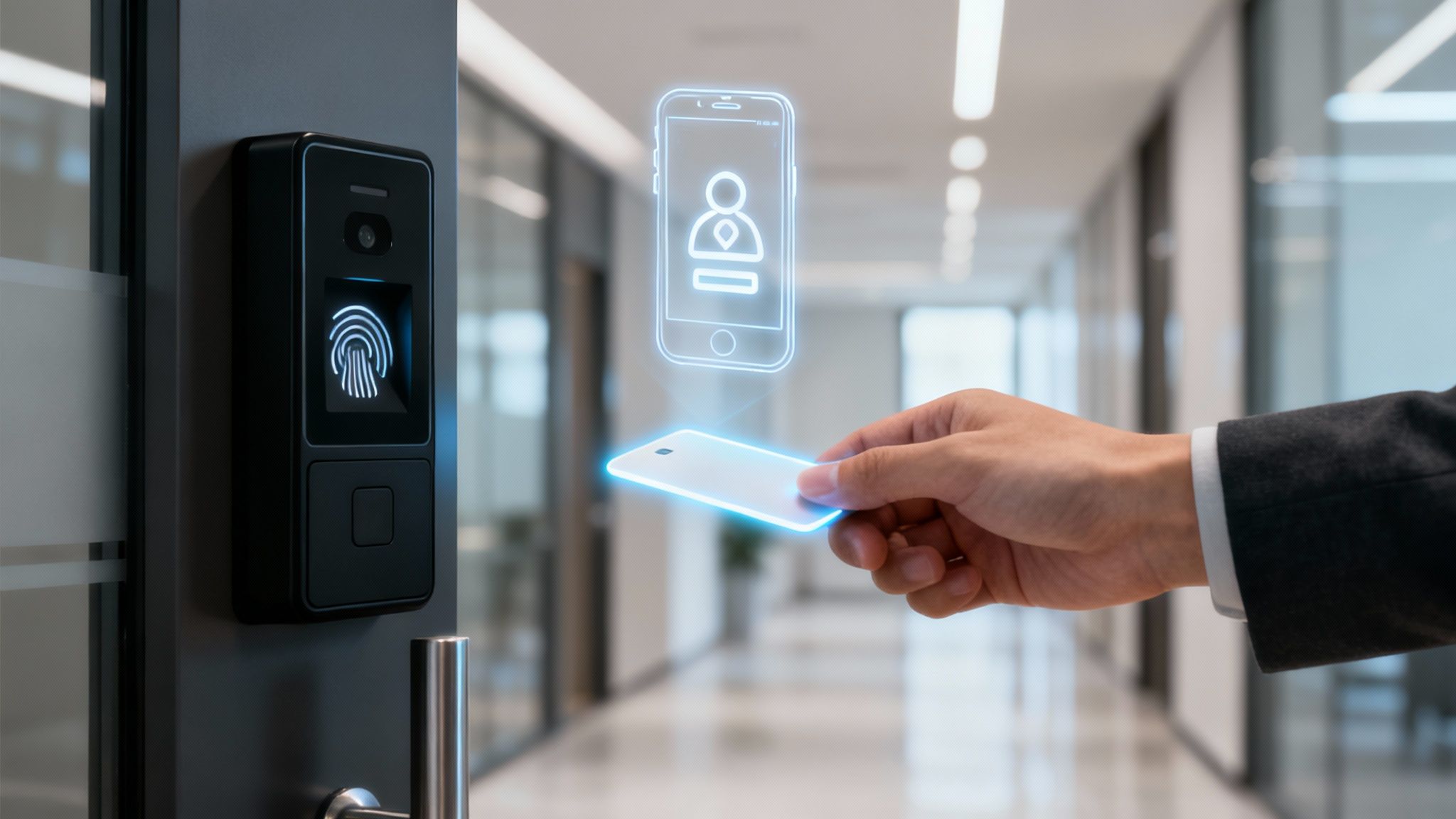
A Guide to Physical Access Control Systems
Physical access control is the digital bouncer for your building. It’s the system that decides who gets to go where, and when, protecting your people, data, and valuable assets. In short, it gives you total control and a clear view of who is on your premises at all times, transforming security from a reactive measure into a proactive strategy.
Why Physical Access Control Is Your First Line of Defence
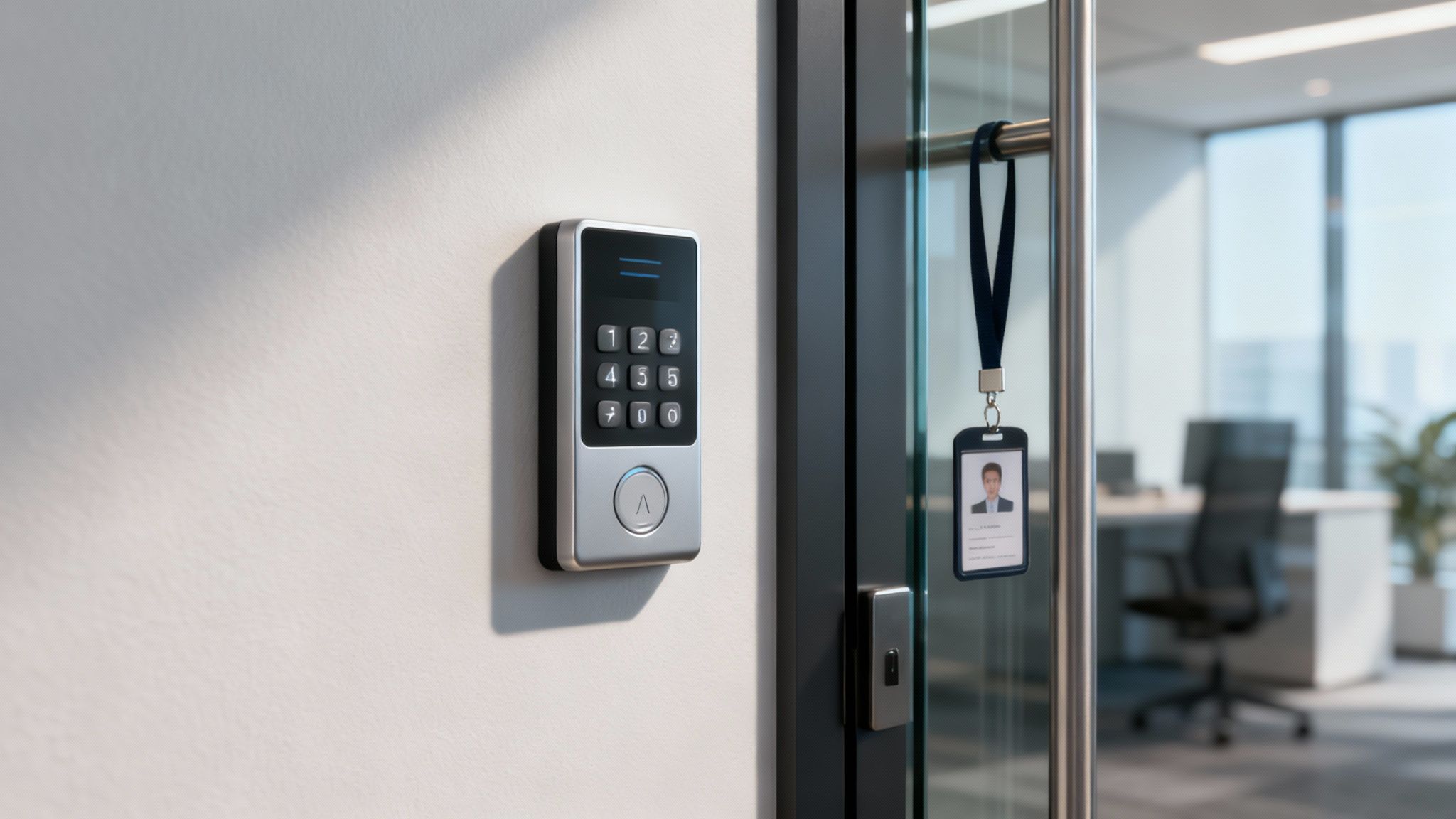
In today's world, a simple lock and key no longer provide adequate protection. As security threats become more sophisticated, businesses are recognizing that their first line of defence isn't just a digital firewall—it's the physical front door. A robust physical access control system proactively secures your premises, preventing incidents before they happen.
You're no longer just locking doors; you're creating an intelligent barrier that logs every entry attempt, grants access based on predefined permissions, and maintains a detailed audit trail. This simple shift transforms your building from a vulnerable space into a secure, controlled environment where every movement is accounted for.
Gaining Control and Peace of Mind
The most significant benefit of a modern access system is the complete operational awareness it provides. It's not just about keeping unauthorized individuals out; it’s about understanding the flow of everyone—staff, visitors, and contractors—throughout your facilities. This visibility is a powerful business asset with benefits extending far beyond basic security.
When you integrate access control with a visitor management system, every guest is accounted for from the moment they arrive. This creates a unified, real-time picture of everyone on-site, delivering critical benefits:
- Enhanced Safety: In an emergency, you have an instant, accurate list of every person in the building, enabling safer evacuations and ensuring everyone is accounted for.
- Improved Efficiency: An automated check-in process eliminates frustrating front-desk bottlenecks. With hosts notified instantly, your team can focus on higher-value tasks, boosting overall productivity.
- Strengthened Compliance: A detailed digital log of all entries and exits simplifies meeting regulatory requirements and provides undeniable proof for incident investigations.
A well-implemented physical access control system acts as a silent guardian. It doesn't just provide security; it delivers the peace of mind that comes from knowing your premises are fully monitored and protected around the clock.
A Growing Priority for Australian Businesses
Market trends confirm the rising importance of physical security. The Australian physical security market is projected to reach USD 4316.30 million by 2033, driven by the adoption of IoT technologies like smart cameras and sensors that enhance real-time monitoring capabilities.
Of course, great security begins with smart building design. Properly resolving space planning issues can dramatically improve your building’s natural defences. By understanding the purpose of physical security safeguards, you can create a more resilient and secure workplace from the ground up. This shift from viewing security as a cost to a strategic investment is why Australian businesses are placing physical access control at the top of their priority list.
Choosing the Right Access Control Technology
Selecting the right physical access control technology is crucial. The goal isn't to find a single "best" option, but to identify the solution that aligns with your unique business challenges, from security needs to company culture and budget.
Moving beyond traditional keys allows you to adopt systems offering superior tracking, management, and overall security. The most common technologies each provide distinct benefits, turning your entry points into smart, controllable gateways rather than simple physical barriers.
This infographic illustrates the evolution from old-school methods to the modern, convenient solutions available today.
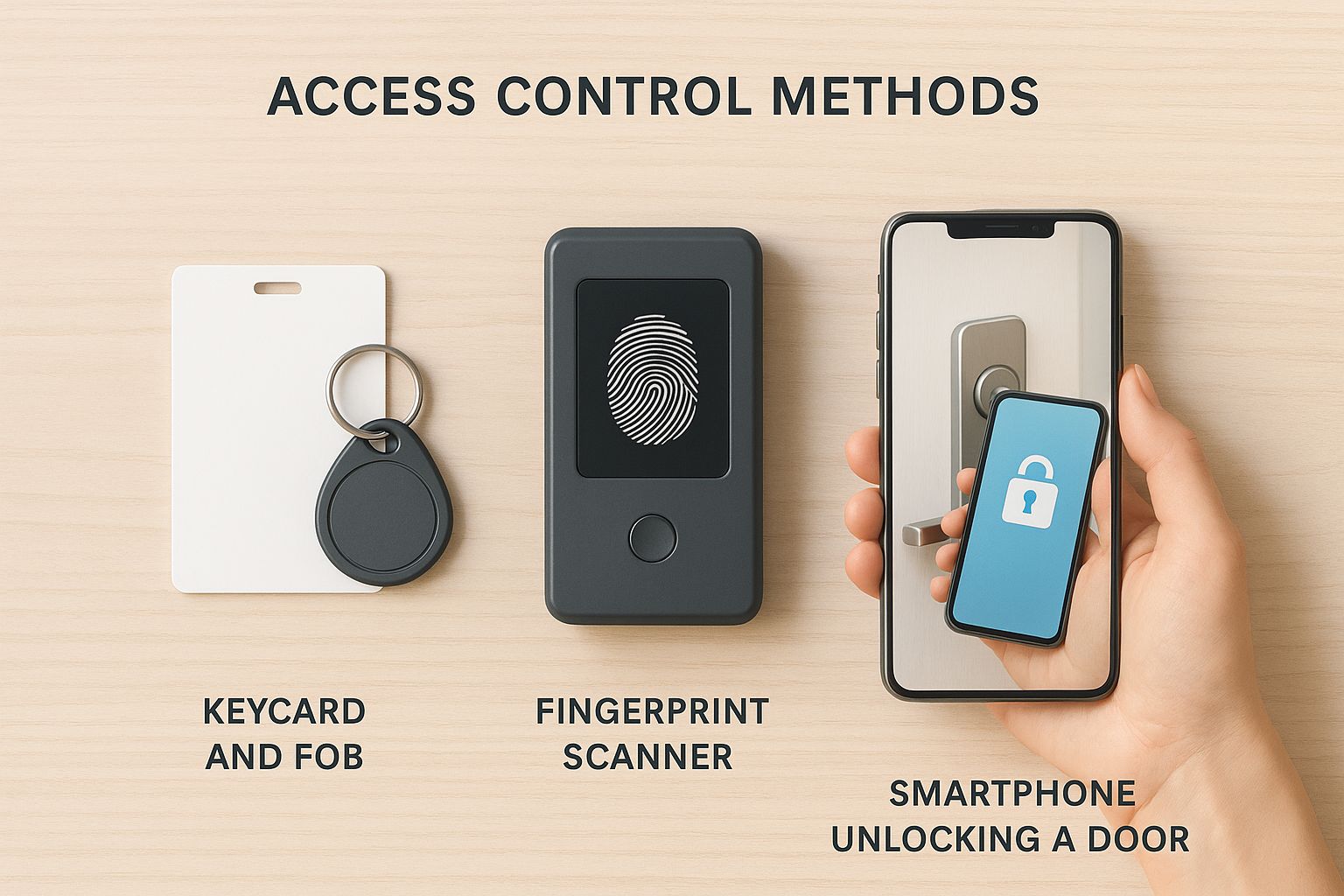
The visual progression from physical cards to unique biometrics and smartphone credentials highlights the industry-wide shift towards more integrated and user-friendly security.
Proven and Practical: Keycards and Fobs
Keycards and fobs are the reliable workhorses of the access control world. They offer a cost-effective and widely adopted solution, ideal for businesses needing a straightforward way to manage access for a large number of employees without a significant financial outlay.
Each card or fob is programmed with unique credentials. When presented to a reader, the system verifies permissions and grants or denies entry. The primary benefit is control; if a card is lost or an employee departs, you can revoke access in seconds, a massive improvement over changing physical locks.
While highly effective, their main drawback is that they can be lost, stolen, or shared, creating a potential security gap. However, this risk can be managed with clear policies and swift administrative action.
The Uniqueness of Biometric Systems
For organizations requiring the highest level of security, biometric systems offer a nearly foolproof solution. These systems use unique biological traits—like fingerprints or facial features—to verify an individual's identity, making it virtually impossible for credentials to be faked or shared.
Biometrics eliminate the risk associated with lost or stolen cards. Tying access directly to an individual's unique identity creates a much stronger, more reliable security posture. As you evaluate your options, remember that various commercial door accessories can also significantly enhance your system's overall capabilities.
The real power of biometrics isn't just heightened security; it's the absolute certainty of knowing exactly who is walking through your doors. This is especially critical in high-stakes environments like data centres or research labs.
If you're curious about the technical side of things, you can dive deeper in our detailed guide on what is facial recognition technology.
The Convenience of Mobile Credentials
The latest evolution in physical access control leverages the one device everyone carries: their smartphone. Mobile credentials turn a person's phone into a secure key, offering unparalleled convenience and flexibility for a modern workforce.
With mobile access, you can grant or revoke permissions remotely and in real-time, which is perfect for managing temporary access for contractors or visitors. This approach also enhances security, as most smartphones are protected by their own layers of security, such as PINs, passcodes, or biometrics.
The trend is clear: 37% of global security leaders have already adopted mobile access, with another 32% planning to implement it soon. This demonstrates a definitive shift towards more dynamic and user-friendly security solutions that fit the way we work today.
To help you decide, here’s a quick comparison of the most common technologies.
Comparing Physical Access Control Technologies
Each access control method strikes a different balance between security, convenience, and cost. This table breaks down the key differences to help you see which one might be the best fit for your organisation.
| Technology Type | Security Level | User Convenience | Best For |
|---|---|---|---|
| Keycards & Fobs | Moderate | High | Businesses needing a reliable, scalable, and cost-effective solution for many users. |
| Biometrics | Very High | Moderate | High-security areas like labs, data centres, and government facilities where identity certainty is non-negotiable. |
| Mobile Credentials | High | Very High | Modern workplaces wanting a flexible, convenient, and future-proof system for employees, visitors, and contractors. |
Ultimately, the right choice depends on your specific environment. A small office has very different needs from a sensitive research facility, so it’s all about matching the technology to the risk.
Unlocking Total Security with Visitor Management
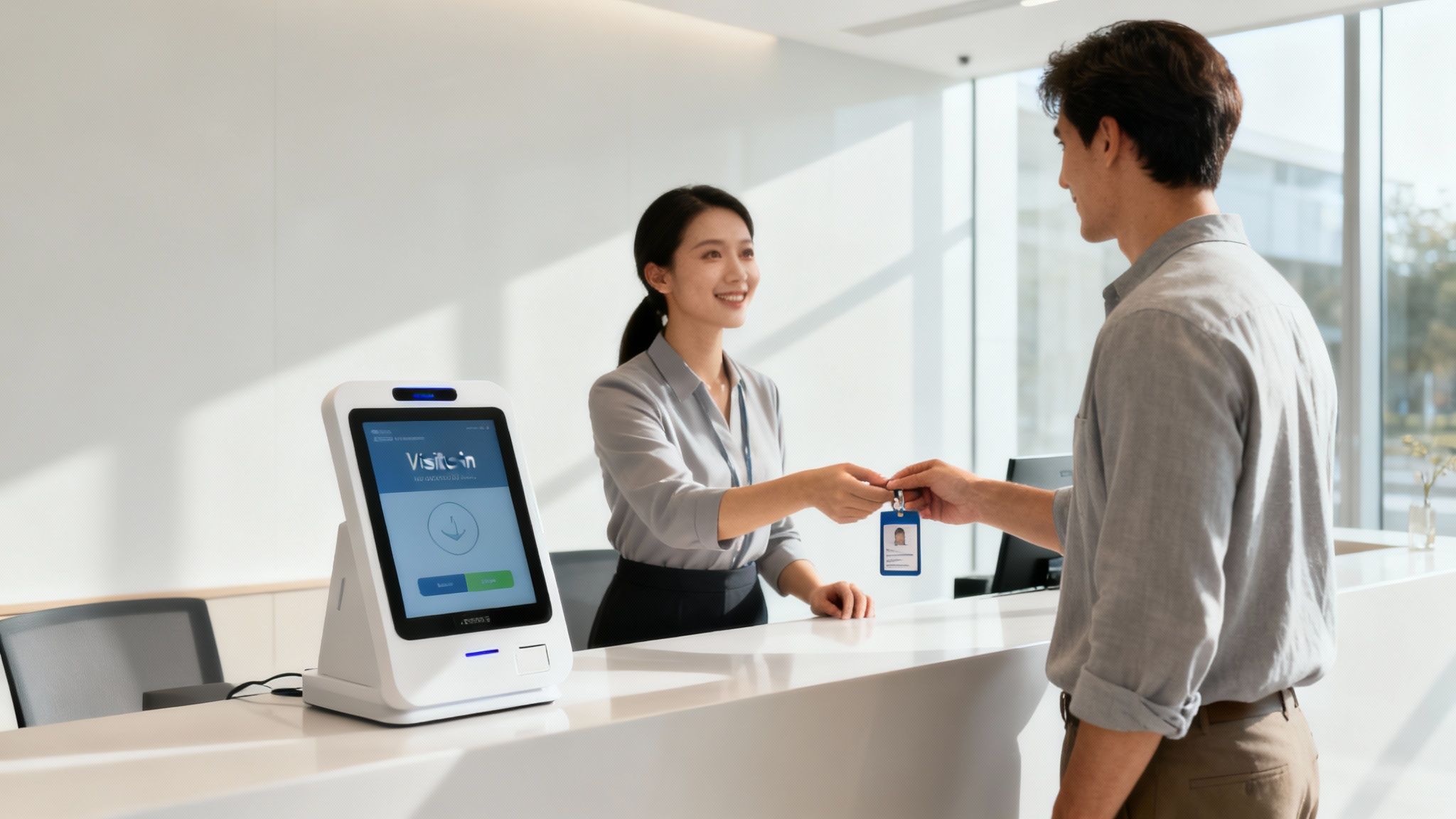
An access control system that only tracks employees is like a fortress with an unguarded gate. You might meticulously monitor your team, but you’re leaving a massive blind spot for every guest, contractor, and delivery driver who enters. This is where security risks often hide in plain sight.
Integrating a visitor management system (VMS) closes this gap permanently. It elevates your security from a partial fix to a complete, 360-degree operation, giving you a real-time, unified view of every single person on-site—not just those with an employee badge.
Creating a Flawless First Impression
The benefits of a VMS begin the moment a guest arrives. A cumbersome paper sign-in book creates administrative headaches and sends a negative message about your brand.
A modern VMS, however, delivers a smooth, professional check-in experience. Visitors can often pre-register, so their credentials are ready upon arrival. This efficiency doesn't just impress guests; it demonstrates that your organization is secure, organized, and forward-thinking.
Integrating visitor management isn't just a security upgrade; it's an investment in your company's image. It communicates professionalism and a commitment to safety from the very first interaction.
This positive experience is more than just a nice-to-have. Research shows that a staggering 74% of customers are likely to buy based on their experience alone. A smooth entry process can make a real difference.
Boosting Operational Efficiency
One of the most immediate benefits of integrating a VMS is the elimination of front-desk bottlenecks. Manual check-ins and frantic calls to find a visitor's host are significant time drains. A VMS automates this entire workflow.
When a guest checks in, the system instantly notifies their host via SMS, email, or a direct message on platforms like Microsoft Teams. This simple automation slashes wait times and ensures visitors are met promptly, creating a frictionless journey from reception to meeting room.
This efficiency also streamlines the management of contractors and temporary staff. You can issue temporary access that automatically activates and deactivates on a schedule, removing the security risk of unreturned keys or cards.
Achieving Unbreakable Audit Trails and Compliance
In today's regulatory landscape, knowing who was on your premises and when is often a legal requirement. When you sync your VMS with your access control system, you create a perfect, unified audit trail for every person who enters your facility.
This detailed digital log is invaluable for compliance and incident response. If a security event occurs, you can instantly pull a report showing every access event, complete with timestamps and visitor details. This data is priceless for investigations and provides solid evidence for regulatory audits.
This integrated approach delivers key compliance advantages:
- Complete Visibility: A single, searchable database tracks staff, visitors, and contractors, leaving no room for error.
- Instant Reporting: Generate detailed reports for safety audits, contact tracing, or compliance checks in just a few clicks.
- Enhanced Accountability: A clear log of every entry and exit ensures everyone is accounted for, which is critical during an emergency evacuation.
To learn more about these platforms, explore our in-depth guide to visitor management systems. This synergy doesn't just improve safety; it boosts efficiency for everyone.
A Practical Plan for Implementing Your System
Implementing a new physical access control system is a strategic project that strengthens your entire security posture. A successful rollout depends on solid planning, clear communication, and a deep understanding of your organization's needs. It’s how you shift from being reactive to security threats to being proactive.
The first and most important step is a thorough security assessment. This is a deep dive into your operational weak spots. Walk your entire premises and identify every potential vulnerability, from main entrances and loading docks to high-value server rooms and executive offices.
This process isn't about creating alarm; it's about gaining clarity to pinpoint exactly where you need to bolster your defences before investing in new technology.
Defining Your Access Rules
Once you know where your vulnerabilities are, the next move is to map out who can go where, and when. The principle of least privilege should be your guide—grant people access only to the areas they absolutely need to perform their jobs.
This means you’ll need to group your workforce and your building into different zones and roles. For example:
- All Staff: General access to main entrances and common areas, but only during business hours.
- IT Department: 24/7 access to critical areas like server rooms and network closets.
- Executive Team: Unrestricted access to all areas, including secure boardrooms.
- Visitors & Contractors: Temporary access, limited only to specific areas and for set timeframes.
A well-defined access hierarchy creates an environment of accountability and significantly reduces the risk of internal threats, which account for a startling percentage of security breaches.
Defining these rules upfront ensures your system is configured for maximum security and efficiency from day one. A core part of managing these rules is knowing how to add or delete an access point in your system.
Selecting Scalable Technology
With your security map and access rules sorted, you can start looking at technology that fits your needs—not just for today, but for the future. Choosing a scalable system is absolutely crucial. As your business grows, your access control solution needs to be able to grow with it without forcing you to start from scratch.
Look for flexible systems. Can you easily add new doors or office locations? Can it integrate with other security tools, like CCTV and visitor management systems? This integrated approach builds a much stronger security posture, which is why 75% of organisations see security system integration as a top priority.
Thinking ahead ensures your initial investment continues to deliver value for years to come.
Planning a Smooth Installation and Training
Finally, even the best system will fail without a smooth installation and proper training. The goal is to cause as little disruption to your daily operations as possible. Work with your provider to map out an installation schedule that avoids your busiest hours, perhaps tackling different floors or departments in phases.
Remember, the most advanced system is useless if your team doesn't know how to use it. Employee training is non-negotiable. Develop a clear communication plan that explains why you’re making this change, focusing on how it keeps everyone safer and simplifies their workday.
Your training sessions should cover the basics:
- How to use the new credentials (card, fob, or mobile app).
- A refresher on the company's access policies.
- Who to contact for assistance or if a credential is lost.
By building your plan on this foundation of assessment, careful planning, and good communication, your new physical access control system will become a genuine asset, not just another piece of hardware on the wall.
Maintaining Compliance and Security Best Practices
Installing advanced hardware is only half the battle. A truly effective physical access control strategy requires an ongoing commitment to best practices and compliance standards. This disciplined approach transforms technology into a robust security framework that protects your business from liability and builds trust.
Without this commitment, even the most sophisticated system can fail. Daily routines, regular checks, and clear protocols are what keep you ahead of evolving threats, especially when handling the personal data your system collects.
Navigating Data Privacy and Compliance
In a data-conscious world, how you manage the information collected by your access system is under intense scrutiny. Standards like the GDPR have set a global benchmark for data privacy, and Australian privacy principles align with these high standards. If your system uses biometrics or logs personal details, you are responsible for protecting that information.
A data breach can lead to massive fines and do irreparable damage to your reputation. A critical first step is maintaining clear, detailed entry logs, which are essential for security audits and regulatory compliance. You can learn more about maintaining compliance with workplace entry logs in 2025 to ensure your processes are up to date.
This focus on data security is fuelling major investment. The Australia Data Center Physical Security Market, for example, is set to grow significantly, hitting USD 94.73 million in 2025 and climbing at a CAGR of 16.84% to reach USD 206.28 million by 2030. This boom is driven by the absolute necessity for rock-solid physical security to protect critical data infrastructure. Read more about the growth in Australia's data centre security market.
Maintaining compliance is not a "set and forget" task. It’s about building a culture of security where privacy and best practices are integral to daily operations. This way, you not only meet legal requirements but also exceed client and employee expectations.
Essential Security Best Practices Checklist
To keep your physical access control system effective and compliant, integrate these essential practices into your regular security routine. They are the foundation of a resilient and trustworthy security operation.
-
Conduct Regular Access Audits: At least quarterly, review who has access to what. The goal is to enforce the principle of least privilege, ensuring employees can only access areas essential for their jobs. This simple check drastically reduces vulnerability to internal and external threats.
-
Maintain Detailed Access Logs: Your system should log every access attempt, successful or not. These logs are your single source of truth for incident investigations and compliance reports. Ensure they are stored securely and are easily searchable.
-
Establish Instant Credential Revocation: A rock-solid offboarding process is crucial. When an employee leaves, their access credentials must be revoked immediately—ideally before they leave the building. This closes a common and significant security loophole.
-
Keep Your System Updated: Like any software, your access control system needs regular updates. These patches often contain critical security fixes that protect against newly discovered vulnerabilities. Skipping them is like leaving a window open for intruders.
By consistently following these guidelines, your physical access control system becomes more than just a gatekeeper. It evolves into a dynamic, intelligent part of your business strategy—safeguarding your assets, protecting your people, and reinforcing your reputation as a secure and trustworthy organisation.
Where Do We Go From Here? A Look at the Future of Business Access
Viewing modern physical access control as just another security expense misses the bigger picture. It is a core investment in your business's resilience, efficiency, and future-readiness. This technology is continually advancing, with cloud-based platforms now serving as central hubs for managing security across multiple locations from a single interface.
Artificial Intelligence (AI) is a key driver of this evolution. AI is making security systems more predictive, enabling them to spot unusual access patterns and flag potential threats before they escalate. This transforms your system from a simple gatekeeper into an active guardian of your premises. The goal is to strike the perfect balance between robust security and a seamless experience for employees and visitors.
Paving the Way for a Safer Workplace
Achieving this balance is happening now. By integrating your physical access control with a visitor management system, you create a powerful, unified security framework. This combination provides total visibility over everyone on-site, streamlines daily operations, and ensures you're prepared for any situation.
The future of access isn’t about building higher walls; it’s about creating smarter doors. An integrated system delivers a welcoming, secure, and efficient environment that empowers your team and impresses your guests.
Now is the perfect time to evaluate your current security setup. Are there gaps in your visibility? Is your front desk still relying on outdated manual processes? Discover how an integrated system from VisitUs can become the cornerstone of a safer, more productive, and more welcoming workplace. It’s an investment that doesn't just protect your assets—it strengthens your entire operation.
Frequently Asked Questions
When exploring physical access control, several questions typically arise. It’s a significant topic, and it's natural to seek clear answers before making any decisions. We've compiled some of the most common queries to provide the straightforward insights you need.
How Much Does a Physical Access Control System Cost?
The cost of a physical access control system varies significantly based on several factors. The final price depends on the type of technology you choose, the number of doors you need to secure, and the complexity of the installation.
For example, a basic, single-door keycard setup might be a relatively small expense. In contrast, a multi-site biometric system integrated with a visitor management platform represents a more substantial investment. It's helpful to think less about the upfront hardware cost and more about the long-term value.
A well-chosen system is an investment, not just an expense. It delivers a real return by reducing the risk of theft, boosting operational efficiency, and protecting your most valuable assets. Always request detailed quotes that break down all costs—hardware, software, installation, and ongoing maintenance—to avoid surprises.
Can This System Integrate with My Other Security Tools?
Absolutely, and it should. Modern access control systems are designed to integrate with other security tools, creating a cohesive and powerful security network. One of the most beneficial integrations is with a visitor management system (VMS), which provides a complete picture of every person on your premises.
Other valuable integrations include:
- CCTV Systems: Linking access events to video cameras provides visual verification for every entry attempt, which is invaluable during an investigation.
- Alarm Systems: Connecting access control to your alarms can trigger an automated lockdown during a breach, securing the entire facility instantly.
- HR Software: Syncing with your HR platform automates the credentialing process. New hires receive access on day one, and a departing employee's access is cut off immediately.
An integrated approach is far more effective than a collection of separate, disconnected security gadgets.
What Happens to the Locks if the Power Goes Out?
This is a critical consideration, and any professional system is designed for this scenario. They include battery backups and specific configurations to ensure your building remains safe and secure during a power outage.
Your locks can be configured in one of two ways for power failures:
- Fail-Secure: When power is lost, the lock remains locked. This is ideal for protecting high-value assets in areas like server rooms or stockrooms.
- Fail-Safe: In this configuration, the lock automatically unlocks when power is lost. This prioritizes safe and quick egress, making it the right choice for main exit routes and high-traffic areas.
A qualified security provider will work with you to configure each door correctly, ensuring you meet local safety regulations while maintaining tight security.
A modern security setup is the backbone of any resilient business. An integrated VisitUs system gives you the control, visibility, and peace of mind needed to protect your people and your property. Find out how our visitor management and access control solutions can create a safer, more efficient workplace for you at https://visit-us.com.
